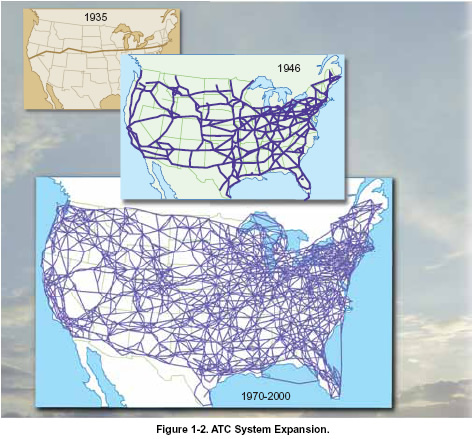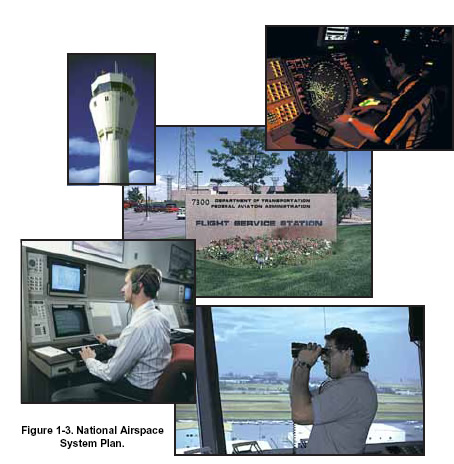 |
|
| INSTRUMENT PROCEDURES HANDBOOK |
|
BRIEF HISTORY OF THE NATIONAL AIRSPACE SYSTEM About two decades after the introduction of powered flight, aviation industry leaders believed that the airplane would not reach its full commercial potential without federal action to improve and maintain safety standards. In response to their concerns, the U.S. Congress passed the Air Commerce Act of May 20, 1926, marking the onset of the government’s hand in regulating civil aviation. The act charged the Secretary of Commerce with fostering air commerce, issuing and enforcing air traffic rules, licensing pilots, certifying aircraft, establishing airways, and operating and maintaining aids to air navigation. As commercial flying increased, the Bureau of Air Commerce— a division of the Department of Commerce—encouraged a group of airlines to establish the first three centers for providing ATC along the airways. In 1936, the bureau took over the centers and began to expand the ATC system. [Figure 1-2] The pioneer air traffic controllers used maps, blackboards, and mental calculations to ensure the safe separation of aircraft traveling along designated routes between cities.
On the eve of America’s entry into World War II, the Civil Aeronautics Administration (CAA)—charged with the responsibility for ATC, airman and aircraft certification, safety enforcement, and airway development— expanded its role to cover takeoff and landing operations at airports. Later, the addition of radar helped controllers to keep abreast of the postwar boom in commercial air transportation. Following World War II, air travel increased, but with the industry's growth came new problems. In 1956 a midair collision over the Grand Canyon killed 128 people. The skies were getting too crowded for the existing systems of aircraft separation, and with the introduction of jet airliners in 1958 Congress responded by passing the Federal Aviation Act of 1958, which transferred CAA functions to the FAA (then the Federal Aviation Agency). The act entrusted safety rulemaking to the FAA, which also held the sole responsibility for developing and maintaining a common civil-military system of air navigation and air traffic control. In 1967, the new Department of Transportation (DOT) combined major federal transportation responsibilities, including the FAA (now the Federal Aviation Administration) and a new National Transportation Safety Board (NTSB). By the mid-1970s, the FAA had achieved a semi-automated ATC system based on a marriage of radar and computer technology. By automating certain routine tasks, the system allowed controllers to concentrate more efficiently on the task of providing aircraft separation. Data appearing directly on the controllers’ scopes provided the identity, altitude, and groundspeed of aircraft carrying radar beacons. Despite its effectiveness, this system required continuous enhancement to keep pace with the increased air traffic of the late 1970s, due in part to the competitive environment created by airline deregulation. To meet the challenge of traffic growth, the FAA unveiled the NAS Plan in January 1982. The new plan called for more advanced systems for en route and terminal ATC, modernized flight service stations, and improvements in ground-to-air surveillance and communication. Continued ATC modernization under the NAS Plan included such steps as the implementation of Host Computer Systems (completed in 1988) that were able to accommodate new programs needed for the future. [Figure 1-3]
In February 1991, the FAA replaced the NAS Plan with the more comprehensive Capital Investment Plan (CIP), which outlined a program for further enhancement of the ATC system, including higher levels of automation as well as new radar, communications, and weather forecasting systems. One of the CIP’s programs currently underway is the installation and upgrading of airport surface radars to reduce runway incursions and prevent accidents on airport runways and taxiways. The FAA is also placing a high priority on speeding the application of the GPS satellite technology to civil aeronautics. Another notable ongoing program is encouraging progress toward the implementation of Free Flight, a concept aimed at increasing the efficiency of high-altitude operations. |

